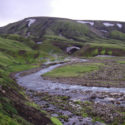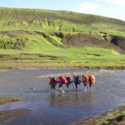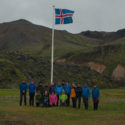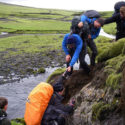The group were all from Essex Wing Air Training Corps, made up of four adult leaders and the rest either cadets or civilian instructors between the ages of 17-20. The whole adventure lasted ten days and was a superb opportunity for all to experience a challenging, demanding and educational expedition in an area of incredible geological significance.
Organisation and training started in March 2014, when Squadrons throughout Essex Wing were informed of the expedition and candidates were invited to apply for a place on it. All candidates were selected based on their previous trekking experience in wild country.
The expedition was preceded by several training days, route and equipment planning meetings, and a practice expedition in the Peak District in May which took place in very challenging cold, windy and wet conditions.
The teams practiced their navigation, river crossings (a highly important skill for trekking in Iceland!), expedition food, tents and equipment.
For the main expedition itself, an advance party of two flew to Reykjavik on Thurs 24th July, and were joined by the main expedition team on Sat 26th. The following day the team focussed on acclimatising, purchasing supplies and some last minute kit preparation. One of the main challenges faced on the expedition was the weight of each individual’s kit required for a five day trekking expedition, in very changeable weather conditions and terrain. Rucksack weights varied but were typically between 22 and 26kg.
Despite a very busy day, the party did have the chance to enjoy a swim in one of Reykjavik’s geothermically heated pools.
On Mon 28th July, the party travelled to see the stunning sights of Geysir and Gulfoss, two of Iceland’s major tourist attractions. The team then travelled on to Landmannalauger in the interior of the country, where they camped for the night (after enjoying the famous natural hot pool there).
The two Duke of Edinburgh Award teams, and the four supervisors/assessors departed Landmannalauger on foot on their expedition the following morning (30th July). The following four days and three nights under DofE assessed conditions, were sent trekking and researching Iceland’s remote, unforgiving but strikingly beautiful interior, and experiencing a mixture of terrain, from mountains, old lava fields, and barren deserts created by volcanic ash and river crossings.
The Groups’ research projects were based on geothermic activity which was evidenced by the frequently occurring bubbling hot pools and steam vents, as well as various types of volcanically formed rocks. The teams also stopped at Alftavatn hut on day 2 to carry out some voluntary work at the campsite there, assisting to generally tidy up the site, much to the appreciation of the volunteer staff based there during the summer.
The last day of the expedition was a particularly marathon effort, as the intended campsite was found to be unusable as the route of the expected water course had changed due to recent seismic activity. The teams had to walk much further than anticipated to find a campsite with a source of water, but at least this meant a much shorter walk the following morning down to the coach pick-up point at Hvisla Holmur.
One of the main mental challenges experienced by the groups was the very remote terrain, and this was overcome primarily by strong teamwork and support for one another. Both teams admitted the trekking was hard, but truly rewarding, with breathtaking scenery and a once in a lifetime experience.
On completion of the expedition, the teams returned to Reykjavik to enjoy some sightseeing. Finally, as no visit to Iceland would be complete without a visit to the Blue Lagoon, the team had the chance to sooth aching limbs after their 100 km trek.
Comments from both teams: amazing, exhilarating, personal achievement, rewarding, good teamwork, great friends and life changing experiences.
Sgt J Skedge and Flt Lt E Chinnery
This expedition was supported by the Ulysses Trust and the RAF Charitable Trust.




